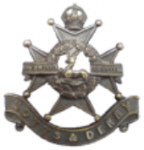



No.115972, Private, Stanley William DAVIES
Aged 19

|
Stanley William Davies was born on 19th ? August 1899 in Ousden (Newmarket Q3-1899 3B:501), baptised in Ousden(St Peter's) on 10th September 1899, son of George William and Elizabeth DAVIES (née KEMP).
1901 census...Aged 1, he was at Ivy Cottage, Ousden with his father George William [55] school master, born Dunkinfield, Cheshire; his mother Elizabeth [40] born Mappleton, Derbyshire; sisters Ida B.M. [11] born Tolworth, Cambs, Gladys E. [7] born Sparkford, Somerset and Lilian A.[6] born Ousden and brother Frederick [3] born Ousden. 1911 census...Aged 11, he was at 52 Raven Street, Derby with his stepfather James Henry JOHNSON [29] Life Assurance agent, born Congleton Cheshire; his mother; sister Mabel Emmeline, brother Clifford DAVIES [9] born Ousden and sister Annie Kathleen [6] born Boston, Lincs., and grandmother Mary GLOVER [85] born Mappleton, Derby |

|
He enlisted in Derby. "Soldiers Died have managed to transform Ousden Suffolk into Howsden, Lincs as his birth place! Attested on 30th December 1916 and placed on Reserves. He gave his address as 52 Raven Street, Derby, age 17 years 143 days, next of kin, his mother Elizabeth Johnson. He was 5 feet 2.75 inches (159.4 cm) tall, weighed 105 lbs (47.8 kg) and chest 34"-36" (86.4 to 91.4 cm). Occupation, apprentice electrical engineer. He was mobilised on 16th April 1918 and posted to 7th Battalion, Sherwood Foresters. Sent to the BEF with the 1st/5th Battalion via Dover-Calais on 18th September 1918. Posted to the 2nd battalion in the field on 21st September 1918 he was killed at an un-named location on 8th-10th October 1918. His mother received his personal effects of one diary and letters, but as can be seen from her letter below, this caused her some concern. This is a typical case of the "Men of 18 in 1918",( the title of a book by F J Hodges), when numbers were getting very low in the Army and as soon as a lad was 18 he was very quickly mobilised and sent to the front. Many units were manned by a great number of these inexperienced young soldiers at this time The battalion were at Tertry, midway between Peronne and Saint Quentin. From the war diary (available on line from National Archives) :- Battalion HQ moved close behind the front line, A,B, and D Coys assembled 300 yard in front of the existing line of resistance and C Coy in support were 200 yards in the rear. A tape had been placed out on which to form up. The Shropshires were on the right and Norfolk on the left with the Leicesters in reserve. At 05:15 our barrage opened up, it was most effective and accurate. The enemy had a few forward posts on our front and these were soon put out of action. A few prisoners and 4-5 machine guns were taken. There were three copses in the front attacked which were of great value in maintaining direction.. DOON MILL COPSE, the first, was on the extreme left flank, and actually in the Norfolk front but the right corner of it was held by enemy who enfiladed our front. The left Coy was held up at first but on the centre pushing on and getting round the flank. The enemy surrendered about 80 prisoners and 5 machine guns were taken most of whom were in the deep dugout. In a similar way a strongpoint on the right was taken with about 100 prisoners. DOON HILL was the next point taken following on close behind the barrage. This hill was taken without much opposition with another 100 prisoners. Thus at the end of the day although the final objective had not quite been reached the battalion had advanced about 400 yards, fighting most of the way, and had captured 5 officers and about 450 O.R.s, besides 6 field guns, 12 machine guns and a good deal of miscellaneous booty. Casualties during the day were 9 officers and 152 O.R.s of whom 2 officers and 16 O.R. s were killed
photo: Commonwealth War Graves Commission click here to go to the Commonwealth War Graves Commission website for full cemetery/memorial details |